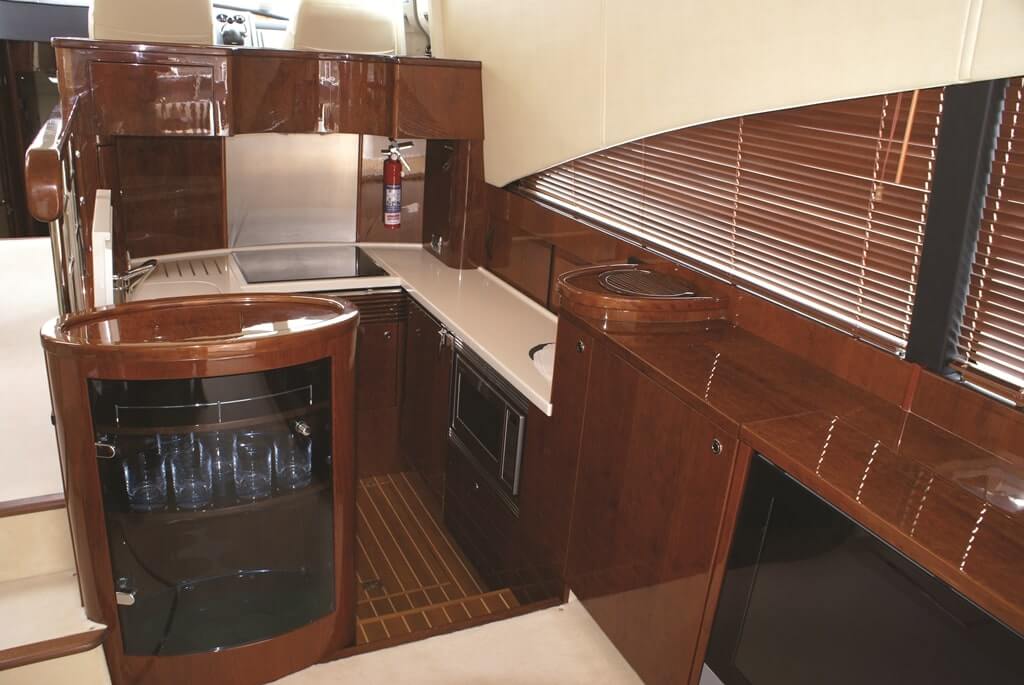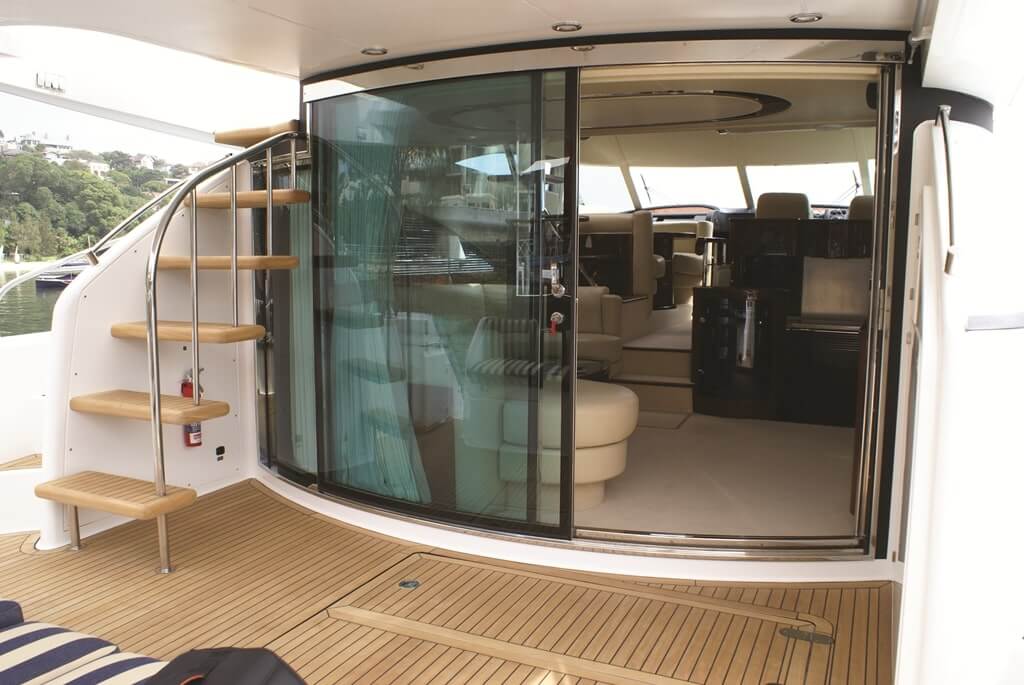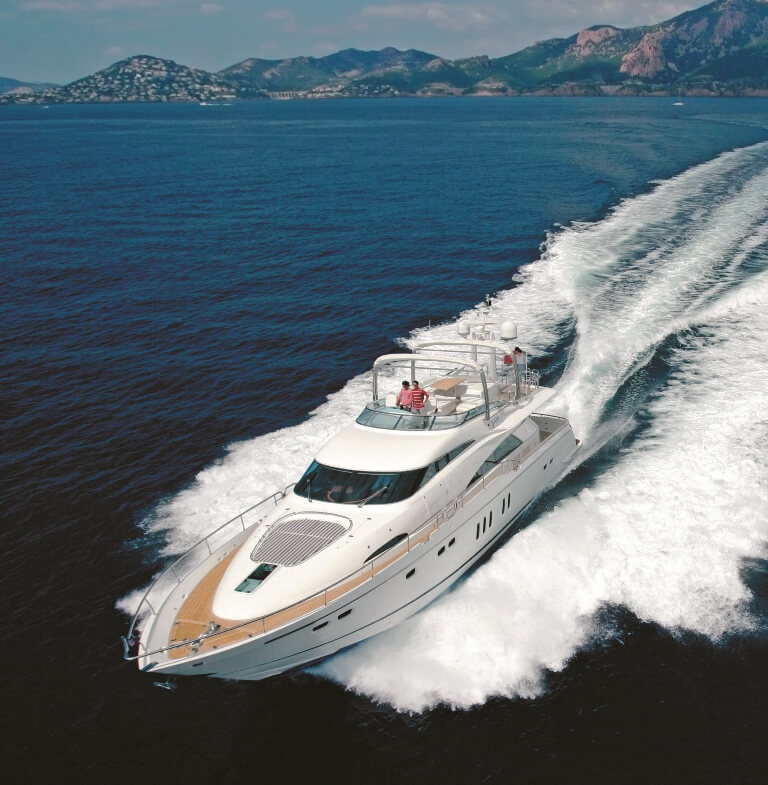Author : David Toyer
Wow Factor
There are times when I board a boat for the first time, and move into the saloon, that I just have to stop, look around, and take it all in. This is what I call the “wow factor” . . . . when I am simply taken aback by those immediate impressions, and there seems to be nothing else to say but wow! The Squadron 58 is one of those boats.
The wow factor on this boat comes from a combination of the integration of space starting with the aft cockpit, moving through the curved glass full width bulkhead, into a very luxurious and spacious, open planned saloon, dining and galley, all topped off by spectacular décor with luxurious finishes, a sensational range of inclusions, workmanship that is impeccable, and a layout that is one of the best to be found in a boat under 60 feet.
This all, however, does come at a price – A$2.485 million to be precise. But when all things are taken into consideration, there is value for money both in a boat that performs well and has more comforts than any other boat of this size can offer.
Squadron, currently comprising 50, 55, 58, 68 and 78 foot models, is the flagship series for the 40 year old UK based company, Fairline Boats. The Targa (with five models from 38 to 64 feet) and Phantom series (40, 48 and 50) complete the range.
As the flagship series, the design brief for each Squadron model was to create a motor yacht that would be best in its class, with uncompromising quality in engineering, equipment, detail and finish.
In reviewing the Squadron 58 there is no doubt that the designers and tradesmen have fully upheld the standards and qualities set by the design brief. Everywhere you look the attention to detail is exquisite and well executed.
The highly polished hand finished joinery with precise matching of veneers on all bulkheads, cabinet and locker doors is impeccable, and with the joinery being hand made alongside each boat in the factory, every component is precisely fitted – this is essential when there is so much curved joinery with intricate detailing for the junction of trims and finishes.
Even something as simple as the shower screen isn’t overlooked. These screens don’t seem to have any of those annoying gaps down each side or along the base where water so easily could leak out over the floor.
Out in the cockpit, the design; the moulding, and the construction of the rope, fender and other storage lockers and hatches including the fixing of the hinges and catches, is first class. There are no rough edges; no flow coated interiors; no screw fixings, with bolts and inserts holding things in place.

The hull itself is built with conventional hand laid glass fibre matting and unidirectional, biaxial and woven rovings over gel coat, while the deck and superstructure incorporate polyurethane foam cores for strength and insulation. More advanced resin infusion and pressure moulding techniques are used for many components such as hatches and bin mouldings to reduce weight and thickness, and provide a finish all round.
The integration of a structural framing grid within the flybridge deck/saloon head enables the flybridge deck to extend beyond the rear of the aft cockpit without the need for any aft struts or other form of support. This gives full protection to the cockpit without giving any sense of enclosure, and the absence of any struts results in a very sleek and rakish style that has become a distinguishing signature design for all the Squadron and Phantom models.

Dual flybridge access is provided with a stair from the rear cockpit and a very open and unobtrusive internal stair that is positioned between the dinette and lounge.
The aft staircase is very user friendly, with the wide, easy going, non slip timber steps providing a comfortable means to get up to the flybridge. With solid handrails and easy going design, these stairs would suit anyone.
On the other hand, the internal stairs may not be to everyone’s liking and are probably best suited for the skipper’s direct access between upper and lower helm station. Being very open in their design (so as not to “close off” the open saloon interior vista) and without handrails, this stair finishes on the upper level, within the upholstered sun lounge to the side of the upper console. It’s therefore, not the easiest way to get to the upper deck for anyone not comfortable with stairs or ladders out on the water. But the aft stair does make up for that. What’s more, neither compromises space or the open vista of the boat’s layout.
The Squadron 58 as reviewed is standard with six berths plus an aft “crew quarters”.
There is an option to fit out the utility room off the kitchen, as additional sleeping quarters, though I doubt that this option, or for that matter, any other layout, would be better suited to the Australasian market than the layout of the boat that is reviewed.
The design criteria was to create spacious, open and free flowing living areas, suited for entertaining and comfortable long range cruising, supplemented by comfortable three cabin/two bathroom accommodation.


Consequently, the Squadron 58 does not provide the owner with the “luxury” of an oversized full width midships stateroom, but instead uses a conventional bow stateroom. This cabin is more than adequate, with a large double island berth, room to move about, abundant storage and hanging space, and high quality furnishings, inclusions and finish.
The same can be said of the other two cabins – a double berth to the port side and the twin berth to the starboard. They are comfortable and more than adequate for the purpose of sleeping and dressing. The double berth cabin has direct (ensuite) access to the second bathroom while the twin cabin shares the same facilities.
With the boat more about living and entertaining, cabin space is not over the top. They are good sized cabins that make use of the space rather than waste it.
Something very unique for a 58 footer – but adding a dimension of practicality for a cruising or entertaining lifestyle, is the utility room that is located down under the dining area and accessed directly off the kitchen. While this can be fitted out for extra sleeping accommodation, as a laundry and drying room or simply as a very easy and accessible storage room directly off the galley (you walk down into this cabin rather than have to climb down a ladder), this space adds another dimension to the versatility of this boat.

It can hold supplies for a long cruise trip; gives a place to wash and dry clothes that is not opening directly off the companionway, and for a corporate entertainer having a big function on board, this is the place to hold all those glasses, drinks, cartons etc without making a mess on the galley bench.
The aft “crew quarters”, accessed via a hatch built into the aft cockpit lounge, also provides options for storage space (dive gear, loose deck furniture etc); as a novelty sleep-out for a couple of kids, or the role after which it was named.
Climate control air conditioning is fitted throughout the interior – one system for the cabins, bathrooms and the utility room off the kitchen, and one for the main saloon level including main screen demister for the lower helm station.
That lower helm station enjoys the luxury of two electrically adjustable, leather lined Recaro helm chairs, and the side cabin door just behind these seats provides the skipper a very direct access out onto the side deck.

Chapman Marine has upgraded the light, sound and entertainment system on this stock boat, with top of the range Bose 321 audio system, a Louwe 32” LCD screen in the saloon and 13” LCDs in the cabins. Underwater transom lighting and recessed blue LED lights around the flybridge and cockpit create wonderful mood lighting that is so spectacular at night.
A couple of other finishing touches such as the telescopic hydraulic passerelle and dinghy lift, and stainless steel swim/boarding platform rails are kept open for a buyer’s option, though two bimini tops, covering both the forward and aft areas of the flybridge deck are now being fitted locally.
Twin 800hp Volvo D12-800 EVCs are installed in the reviewed boat, and the factory offers options for either the Volvo D12-715 EVCs or Caterpillar C15-811s. There is only a couple of knots variation in performance from these three options, with top speeds ranging from 31 to 33 knots and cruise speeds around the 24 to 25 knot range.
The hull is described as being deep V forward, flattening off to an 18 degree deadrise at the transom and both prop shafts and propellers are semi recessed into tunnels. As usual, this allows a flatter shaft angle, a reduction in draft, and with the hull extended right to the back of the boarding platform, the props are positioned further aft. All of this, it is claimed, improves efficiency by allowing the hull to plane flatter, with less power and hold a flatter trim angle.

To finish, I’m going to use a very old and often overused summation and say that Fairline has not wasted a millimetre of space throughout this boat. Built-in storage can be found everywhere, and spatial priorities given to areas that are the most important, without doing so at a cost elsewhere.
The workmanship and attention to detail is exceptional and this, along with the extensive list of standard equipment and fit-out, is reflected in the bottom line.
The Squadron 58 carries a premium price tag but has that “wow factor” to justify that outlay.
The open planned saloon, with the curved glass bulkhead and large sliding door, integrates indoor and outdoor living spaces superbly, and the extended overhead flybridge deck ensures that the cockpit is usable in bright overhead sun or in light rain.
In the Australian climate, it’s essential that the two bimini tops are installed over the enormous flybridge deck if full use is to be made of the facilities that are provided. This includes the vast aft lounge that wraps around the dining table, the built-in cooking station and wet bar, and of course the forward helm console and its vast lounging areas

Specifications
- Design Name: Squadron 58
- Builder: Fairline Boats Ltd
- Designer: Bernard Olesinki
- Interior Designer: Fairline Boats Ltd
- Year Launched : 2008
- LOA: 17.91m
- LWL: 17.57m
- Beam: 4.85m
- Draft: 1.39m
- Displacement: 23.5 tonnes
- Max Speed: 32 knots
- Cruise Speed: 25 knots
- Fuel: 2727 litres
- Water: 1008 litres
- Construction: GRP
- Engine: 2 x Volvo D12-800 EVC
- Base Price: A$2,250,000
- Reviewed Price: A$2,485,000




